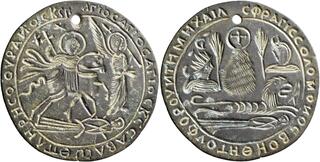| Leu Numismatik AG > Web Auction 29 | Auction date: 24 February 2024 |
| Lot number: 2781 Price realized: 1,100 CHF (Approx. 1,249 USD / 1,154 EUR) Note: Prices do not include buyer's fees. | Show similar lots on CoinArchives Find similar lots in upcoming auctions on |
| Lot description: UNCERTAIN EAST. Levantine region or Egypt, circa 6th-7th century. Amulet (Bronze, 51 mm, 14.37 g, 12 h). ΑΓΙΟC ΑΓΙΟC ΑΓΙΟC K(VPIO)C CABAⲰΘ ΠΗΛΡΗC O OVΡΑИΟC KS Γ, ('Holy, Holy, Holy, Lord of Hosts, heaven and earth are full') Holy Rider galloping right, holding spear in the form of a cross in his right ha, spearing a prostrate female demon; to right, angel advancing right, holding cross in his left hand; to upper left, two stars. Rev. CΦΡΑΓΙC COΛOMOИOC BOHΘH TOV ΦΟΡΟVИΤΗ ΜΗΧΑΙΛ ('Seal of Solomon, help the wearer, Michael') Mount Golgotha (?) surmounted by cross within circle between two torches; to left, radiate bust of the Sun to right, raising his right hand; to upper left, crescent between decorations; to right, bust of the Moon to left, wearing crescent; in lower register, lion running right towards the Evil Eye, which is pierced by spear or arrow; below, prostrate female demon. Cf. T. Matantseva (1994), Les amulettes byzantines contre le Mauvais Oeil du Cabinet des Médailles, in: Jahrbuch für Antike und Christentum 37, p. 110-121, notably plate 14, no. a. (for quotation of the Sanctus) and c. (for basic iconography). A highly fascinating amulet with intriguing iconography. Pierced and with some spots of active corrosion, otherwise, extremely fine. From a European collection, formed before 2005. Through its legends and its iconography, this object can be identified as a magical amulet. It belongs to an eclectic group of late antique amulets showing imagery of the 'Holy Rider' spearing a female demon and the vanquishing of the Evil Eye. The obverse legend is derived from the 'Sanctus', an important hymn that is still used in both Catholic and Orthodox liturgy today. The part of the hymn that appears on our amulet is a quotation from Isaiah 6:3. Interestingly, the engraver ran out of space, resulting in the omission of the latter part ('of thy glory') and only the initial letter appears for 'earth'. 'Holy Rider' imagery, as seen on the obverse, appears on a large and heterogeneous group of mostly haematite, bronze and lead amulets. Their date is debated, but most objects appear to originate between the 5th and 7th centuries. On the gems, the Holy Rider is usually named 'Solomon' in allusion to the late antique tradition of king Solomon as master of demons. It was believed that king Solomon received the 'Seal of God' from the Archangel Michael, a magical ring allowing him to command demons, thus enabling him to build the Temple in Jerusalem. This tradition is also alluded to in the reverse legend of our amulet, in which its 'wearer', named Michael, invokes the 'Seal of Solomon' to protect him. The iconography on the reverse is less straightforward. The identification of the central object on the reverse is not clear, but it might well be mount Golgotha between Sun and Moon. Many of the earliest Crucifixion scenes typically show flanking personifications of the Sun and Moon as well. In the lower register, we see a variation of the vanquishing of the evil eye, a scene that usually appears as the main device on this type of amulet. On our amulet, a small evil eye pierced by a spear or an arrow appears to the right of a running lion, attacking it. Below, the same prostrate demon appears as on the obverse. Evidently, this amulet was meant to protect its wearer from harm, specifically from demons and the evil eye. It is fascinating to see how during the early Byzantine period themes and phrases that were outspokenly Christian were appropriated into the age-old Roman practice of magic. Starting price: 200 CHF |  |



